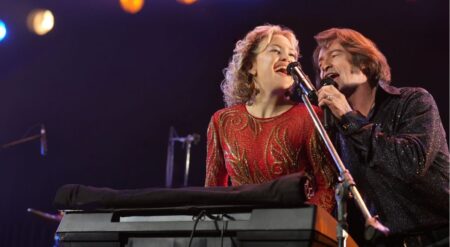
There’s a quote from Jewish text that has always been foundational in my life, “In a place where there are no people, strive to be a person.” It’s hard to review a film about the Holocaust. It’s personal, it’s fraught, it’s trite, and yet, it’s necessary again and again. Telling and retelling these stories is the only way to pass them down. It’s the only way that, maybe, my students won’t have to go to school every single year to find swastikas on their desks and bathroom stalls, virtually ignored by the town every single time. It’s the only way that, maybe, the atrocities committed against my people won’t be used as crude, and abhorrent shorthand for the slightest inconvenience people feel is foisted on them. My Best Friend Anne Frank (Mijn beste vriendin Anne Frank), a Dutch-language Netflix Original movie by Ben Sombogaart, isn’t going to end antisemitism. It isn’t going to cure Holocaust denial. But it is light where there was none; proof of life where there was no life. It’s the true story of Hannah (Josephine Arendsen), who chose to be a person in a place where there were no people.
Hannah Goslar was, and still is, a real girl who really endured the Holocaust alongside her best friend Anne Frank (played by Aiko Beemsterboer). The film goes back and forth, chronicling their life before the Bergen-Belsen concentration camp and their time interned there. The former scenes largely serve to establish their intimate relationship, while the latter mostly exists to display the atrocity of the Nazis. Textually, the way this is demonstrated reaches beyond the typically portrayed play of little girls. There’s plenty of tossing balls and trying on making up. But much of that half of the film is spent talking about french kissing boys, getting into rows about it several times over and repeatedly making up, and putting Hannah in uncomfortable situations discussing anatomy and sexuality.
This all one-hundred percent reflects the normal lives of children in a way that felt odd and uncomfortable at first, given it’s a movie about children and the Holocaust. But I think the intention was to use such an extreme example of how normal their lives were to most clearly circle the point that even the worst of humanity couldn’t take their humanity away. A bold direction, and frankly, I think it worked. And certainly, this is helped by actors’ excellence. Both are incredible at showcasing the breadth of human emotion across the film.
Visually, the movie was a bit heavy-handed. The “before” scenes are oversaturated to make the colors brighter, already filled with colorful dresses and props. Meanwhile, the concentration camp scenes are entirely desaturated so as to remove most of the color while depicting a more sanitized version of what the inside of the concentration camp likely looked like. People did not look the kind of sick, starved, and worse than they should probably have. Instead, they’re covered in dirt and made to look a bit ragged. I can’t really discern a reason to tame the visualization of the concentration camp when there are already other depictions not child-friendly besides probably just not having the budget for it. It all, unfortunately, becomes a bit distracting, though not terribly detracting from the overall value of the movie.
Because ultimately, it’s the final part of the movie, only as affecting as it is because of the two concurrent stories that proceed it, that is what makes My Best Friend Anne Frank what it is. Two generalizations about the Jewish people I think I may be permitted to make are that we are realists, and we are optimists. You don’t survive thousands of years of persecution without that winning combo. We are quite self-aware that the world has never been kind to us (I mean, just turn on the news any given week). But we don’t just go around telling stories of tragedy and loss to pass the time. Whether it’s when we invite Holocaust survivors to speak or when we retell ancient stories of our people or share in the modern blessings of our thriving, our stories always remain hopeful, forward-thinking, and couched in a core belief that we will survive anything.
My Best Friend Anne Frank, is one of these stories. A girl who chose to be a person at great risk and for no other reason than it was the right thing to do for the person she cared about more than anyone in the world. It’s not told perfectly, but the fact that it’s been told at all, and the fact that it’s been told well and with small moments that prove it’s being told from the specifically Jewish perspective it deserves to be, gives it a great value. It’s bold in ways I didn’t expect it to be. It’s inspiring in the ways I knew it would be but cried over anyway. And for all that, it’s wholly worthy an addition to the canon of not just Holocaust stories but Jewish stories altogether.
My Best Friend Anne Frank is streaming now on Netflix.
My Best Friend Anne Frank
-
Rating - 7/107/10
TL;DR
It’s not told perfectly, but the fact that it’s been told at all, and the fact that it’s been told well and with small moments that prove it’s being told from the specifically Jewish perspective it deserves to be, gives it a great value. It’s bold in ways I didn’t expect it to be. It’s inspiring in the ways I knew it would be but cried over anyway. And for all that, it’s wholly worthy an addition to the canon of not just Holocaust stories but Jewish stories altogether.






